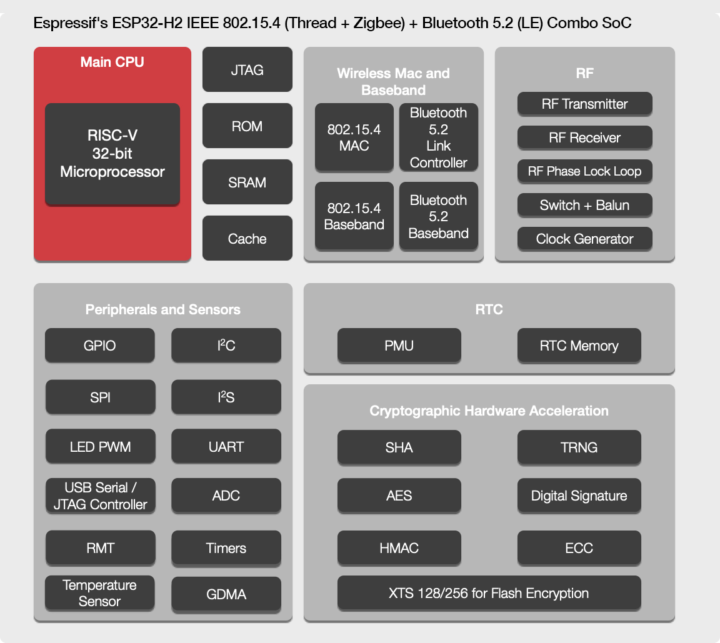Just a few days ago, we noted ESP32-H2 802.15.4 & BLE RISC-V SoC had shown up in the source code, and tried to derive specs and a block diagram from the info seeing it was similar to ESP32-C3, but swapping the WiFi radio for an 802.15.4 radio.
We don’t need to guess anymore, as Espressif Systems has just announced ESP32-H2 RISC-V WiSoC with support for Zigbee 3.x, Thread 1.x through the 802.15.4 radio, as well as Bluetooth LE 5.2.

- CPU – 32-bit RISC-V core (at up to 96 MHz)
- RAM – 256 KB SRAM
- Storage – External flash support
- Wireless connectivity
- IEEE 802.15.4 radio with Zigbee 3.x and Thread 1.x support, Matter protocol
- Bluetooth 5.2 (LE) radio designed in-house, with support for direct connection, Bluetooth Mesh, Bluetooth LE Audio
- Future support for Matter protocol (previously Project CHIP) using either radio
- Peripherals – 26x programmable GPIOs with support for ADC, SPI, UART, I2C, I2S, RMT, GDMA, and PWM
- Security – ECC-based secure boot, AES-128/256-XTS-based flash encryption, digital signature, HMAC peripheral for identity protection, cryptographic accelerators
- Integrated DC-DC converter for ultra-low-power, energy-efficient operation.
ESP32-H2 will be supported through Espressif’s IoT Development Framework (ESP-IDF), and you can check out the software development progress on Github.
That’s about all we know at this stage, no information about availability, modules, or development boards. ESP32-H2 is the first wireless SoC from the company that does not use WiFI, and it will specifically target low-power Smart Home applications.

Jean-Luc started CNX Software in 2010 as a part-time endeavor, before quitting his job as a software engineering manager, and starting to write daily news, and reviews full time later in 2011.
Support CNX Software! Donate via cryptocurrencies, become a Patron on Patreon, or purchase goods on Amazon or Aliexpress




